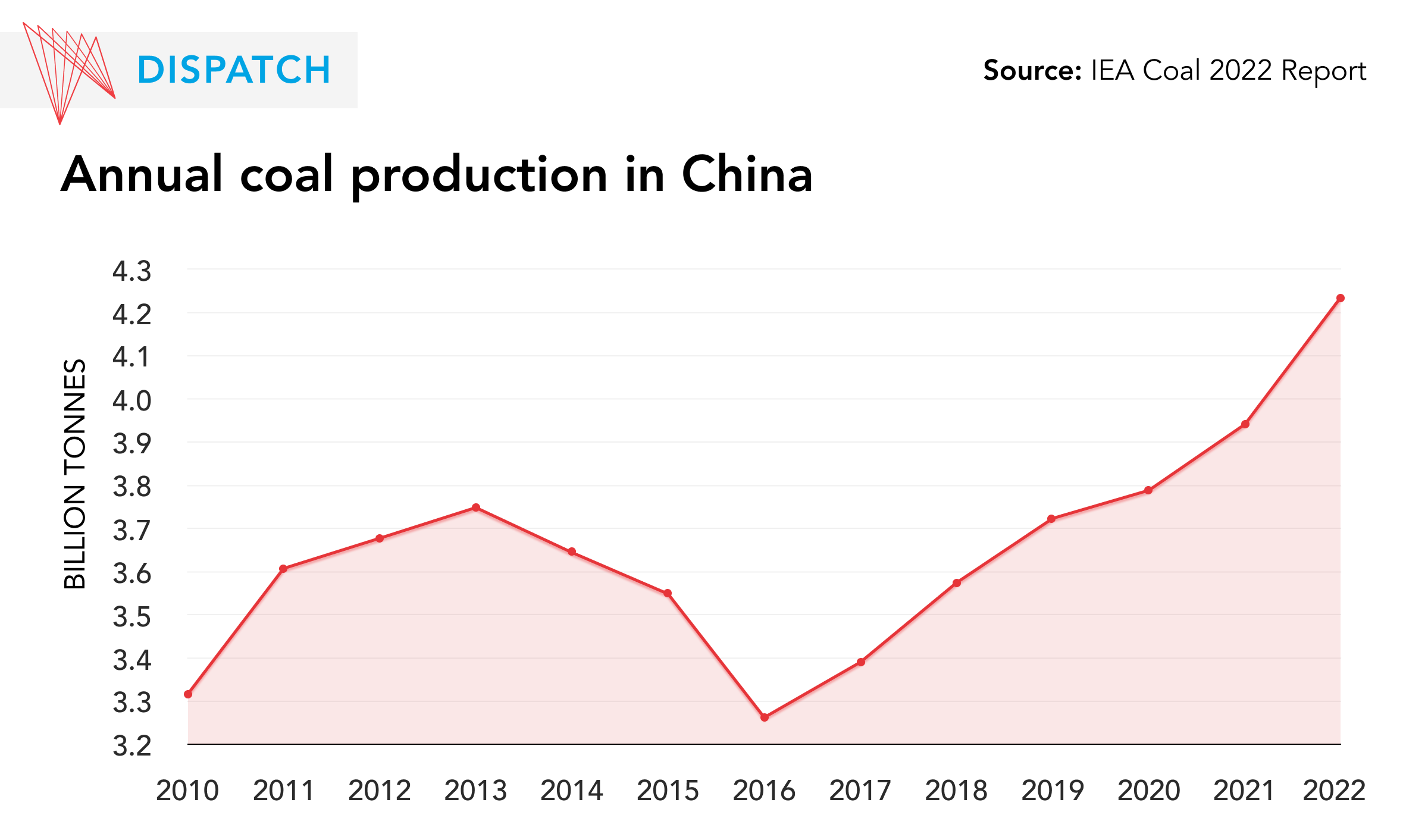As the world’s largest coal producer and consumer, China knows that its reliance on coal must be curbed if it is serious about its commitment to peak its carbon emissions by 2030 and reach carbon neutrality by 2060. Although growing concerns about national energy security are fuelling a short-term increase in coal output and power, any net-zero pathway for China will require a phase-down, if not a total phase-out, of coal.
This is much easier said than done. According to the International Energy Agency, coal provided more than 60 per cent of China’s total energy supply in 2020. In a bid to keep domestic energy prices low, meet peak electricity demand fluctuations, and reduce its reliance on coal imports amid geopolitical tensions, China has continued to ramp up coal production, reaching a record 4.24 billion tonnes in 2022. For comparison, India, the world’s second-largest producer of coal, only produced 893 million tonnes that same year.

The sheer scale of the Chinese coal industry means that an energy transition would result in unemployment in the medium and long term for millions of Chinese workers at every stage of the coal value chain. In recent modelling by analysts, jobs supported by China’s coal sector could fall from 2.7 million in 2021, to 1.44 million in 2035 and 94,000 in 2050, “with job losses from mining alone expected to exceed 1.1 million by 2035.”
The projected unemployment will be concentrated in the autonomous regions of Inner Mongolia and Xinjiang and in provinces like Shanxi and Shaanxi, particularly in poorer and rural areas. Unemployed coal workers will also struggle to find new jobs due to their age and their relatively low education and skill levels; for example, half of all coal miners are over the age of 45, and 60 per cent possess a junior middle school level of education or less.
The concept of a just transition in the energy sector has gained prominence in recent years as the inequalities of decarbonization have emerged. At its core, a just transition means “greening” the economy in a fair and inclusive manner, so that workers and communities in affected sectors do not bear the brunt of decarbonization. China is certainly not alone in facing the challenges of implementing a just transition in the coal sector; think of the decline of coal mines in central Appalachia in the U.S. or the pit closure programs of the 1960s and 1980s in the U.K.
In Canada, the federal government created the Task Force on Just Transition for Canadian Coal Power Workers and Communities as it moves to phase out coal. After meeting with affected communities, the task force issued recommendations stressing the importance of meaningful public engagement and government policy that will support re-employment or allow other workers to “retire with dignity.” However, the 2022 Just Transition Report by the Office of the Auditor General of Canada found that the federal government is still “not prepared to support a just transition to a low-carbon economy for workers and communities.” Although the federal government has committed C$185 million for communities affected by the coal phase-out and recently introduced the Sustainable Jobs Plan, six of the 10 task force recommendations have yet to be implemented.
China has seen similar job losses in the coal industry before. Although coal output has consistently increased, coal sector employment has already been in decline due to improvements in efficiency. In 2013, there were 5.29 million workers in the Chinese coal industry — nearly double the number of jobs today. The high rate of layoffs throughout the 2010s has prompted the central government to commit C$18.8 billion (100 billion yuan) for affected workers in the coal and steel industries since 2016. However, these policies have mostly focused on relocation and re-employment elsewhere in the coal industry for workers in state-owned enterprises (SOEs), with subsidies for laid-off workers who cannot find jobs immediately. If coal is to be phased down, this strategy will no longer be viable. China must retrain and integrate workers from both SOEs and private mines into more sustainable industries or provide the means for older workers to enjoy an early retirement.
Reducing China’s dependence on coal would also create massive public health benefits. Coal is a major contributor to air pollution in China, which the World Health Organization estimates is responsible for around 2 million deaths in China each year. These premature deaths are linked to not only open-air pollution from coal-fired power plants, but also residential coal burning, which releases deadly particulates from unprocessed coal in enclosed spaces. There is a significant degree of energy poverty in rural areas, such as the regions that will be affected by a coal phase-out, and affected households typically rely on burning raw coal at home for heating, cooking, and boilers. A just transition must therefore ensure equitable electrification and access to cleaner and affordable energy sources, which will reduce the prevalence of respiratory diseases and help close China’s urban-rural socio-economic divide.
Similarly, the Chinese government must also address the occupational health and safety dimension of a just transition, since coal workers’ pneumoconiosis, commonly referred to as “black lung disease,” is the most common occupational disease in China. There are an estimated 6 million Chinese who suffer from pneumoconiosis, but very few coal workers have secured compensation from mining companies. Part of a just transition package for laid-off workers in the coal sector must include sufficient compensation and health-care insurance for those suffering from respiratory diseases linked to their occupations.
Given the highly localized nature of China’s coal sector, there is no one-size-fits-all approach to coal worker retraining and relocation. One issue is that major SOEs have entire communities, including hospitals and schools, built around existing mines, resulting in reluctance among unemployed workers to relocate. China’s central government should co-operate with local governments at the provincial, prefectural, county, and township levels to create policies tailored to regional circumstances. However, with the central government’s current focus on optimizing coal production and power, there has been minimal effort on their part to co-ordinate a just transition.
Some local governments have begun to implement green transitions for coal-dependent communities. In Liaoning Province, the provincial government is investing C$117 billion (600 billion yuan) in clean energy expansion, with new renewable energy projects, such as wind turbines, being built in former coal-dependent towns like Fuxin. In Xuzhou, Jiangsu Province, a coal mine subsidence lake was reclaimed and transformed into the Pan’an Lake Wetland Park, now a popular tourist attraction. But these projects have been piecemeal, and there has been little interest in centring affected workers and their communities in green transition initiatives. The central government will need to provide an explicit mandate for a just transition to local governments and co-ordinate efforts to ensure that all workers are meaningfully cared for and included in a future green economy.
A long-term phase-down of coal in China will be difficult, but necessary, in the global fight against climate change. Implementing a just transition in China’s coal industry will ensure that millions of Chinese coal workers do not bear the economic cost of a green transition. If Chinese officials invest in affected workers, electrify energy-impoverished communities, address the public health consequences of coal, and develop sustainable economic alternatives for coal-dependent communities, China can become a global model for just transitions, and its economy and society will be much better off because of it.





